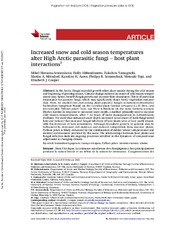| dc.contributor.author | Moriana Armendariz, Mikel | |
| dc.contributor.author | Abbandonato, Holly | |
| dc.contributor.author | Yamaguchi, Takahiro | |
| dc.contributor.author | Mörsdorf, Martin Alfons | |
| dc.contributor.author | Aares, Karoline | |
| dc.contributor.author | Semenchuk, Philipp | |
| dc.contributor.author | Tojo, Motoaki | |
| dc.contributor.author | Cooper, Elisabeth | |
| dc.date.accessioned | 2022-02-09T12:47:58Z | |
| dc.date.available | 2022-02-09T12:47:58Z | |
| dc.date.issued | 2021-05-07 | |
| dc.description.abstract | In the Arctic, fungal mycelial growth takes place mainly during the cold season
and beginning of growing season. Climate change induced increases of cold season temperatures may, hence, benefit fungal growth and increase their abundance. This is of particular
importance for parasitic fungi, which may significantly shape Arctic vegetation composition. Here, we studied two contrasting plant parasitic fungi’s occurrences (biotrophic
Exobasidium hypogenum Nannf. on the vascular plant Cassiope tetragona (L.) D. Don., and
necrotrophic Pythium polare Tojo, van West & Hoshino on the moss Sanionia uncinata
(Hedw.) Loeske) in response to increased snow depth, a method primarily used to increase
cold season temperatures, after 7–13 years of snow manipulation in Adventdalen,
Svalbard. We show that enhanced snow depth increased occurrences of both fungi tested
here and indicate that increased fungal infections of host plants were at least partly responsible for decreases of host occurrences. Although bryophyte growth, in general, may be
influenced by increased soil moisture and reduced competition from vascular plants,
Pythium polare is likely enhanced by the combination of milder winter temperatures and
moister environment provided by the snow. The relationships between host plants and
fungal infection indicate ongoing processes involved in the dynamics of compositional
adjustment to changing climate. | en_US |
| dc.identifier.citation | Moriana Armendariz, Abbandonato, Yamaguchi, Mörsdorf, Aares, Semenchuk, Tojo, Cooper. Increased snow and cold season temperatures alter High Arctic parasitic fungi – host plant interactions. Arctic Science. 2021 | en_US |
| dc.identifier.cristinID | FRIDAID 1981567 | |
| dc.identifier.doi | 10.1139/as-2020-0027 | |
| dc.identifier.issn | 2368-7460 | |
| dc.identifier.uri | https://hdl.handle.net/10037/23998 | |
| dc.language.iso | eng | en_US |
| dc.publisher | Canadian Science Publishing | en_US |
| dc.relation.journal | Arctic Science | |
| dc.relation.projectID | info:eu-repo/grantAgreement/RCN/FRIMEDBIO/230970/Norway/The effect of snow depth and snow melt timing on arctic terrestrial ecosystems// | en_US |
| dc.rights.accessRights | openAccess | en_US |
| dc.rights.holder | Copyright 2021 The Author(s) | en_US |
| dc.title | Increased snow and cold season temperatures alter High Arctic parasitic fungi – host plant interactions | en_US |
| dc.type.version | publishedVersion | en_US |
| dc.type | Journal article | en_US |
| dc.type | Tidsskriftartikkel | en_US |
| dc.type | Peer reviewed | en_US |


 English
English norsk
norsk